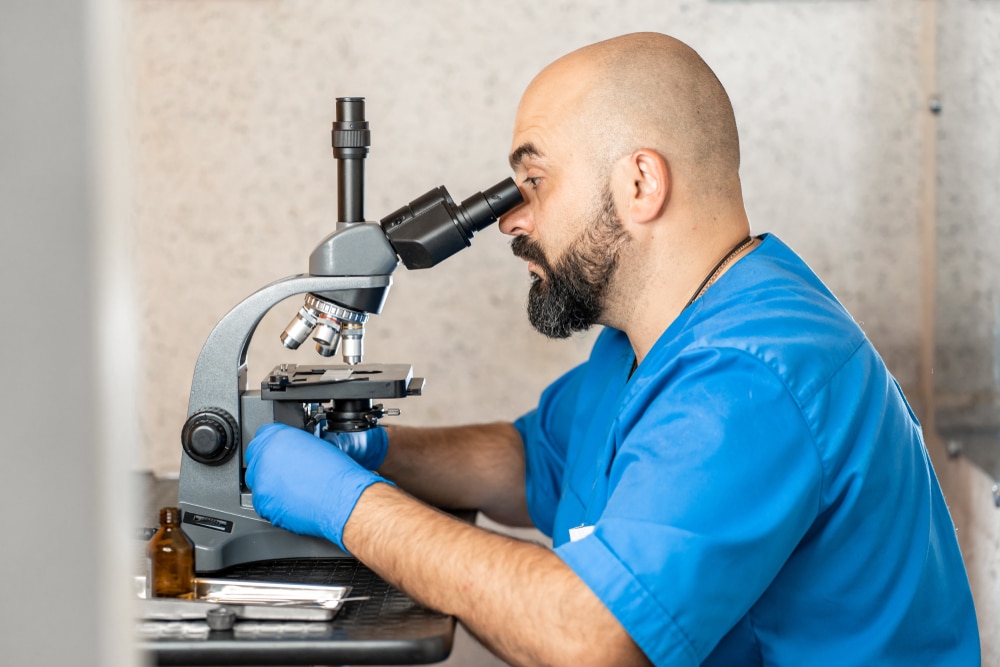Vets often ask for owners to bring a sample of their dog’s poop to a checkup. Have you ever wondered why, though? In other words, why do vets examine a dog’s poop?
Vets examine a dog’s poop to identify the problems related to gut health, like constipation, worm infestation, diarrhea, or dysentery. This can also help detect disease conditions like enteritis, which can be caused by food-related intoxications, food change, high worm load, absorptive problems, protozoan infections like giardiasis, and lastly, bacterial or viral infections of the alimentary tract.
Table of Contents
- What Is A Fecal Examination And Why Is It Important For Dogs?
- What Does A Dog’s Fecal Examination Examine?
- What Types Of Worms Can A Fecal Examination Detect?
- How Are Diarrhea And Constipation Detected?
- Why Does My Dog’s Poop Have Bubbles In It?
- What Is The Difference Between Melena And Hematochezia?
- How To Identify Bacterial And Viral Infections Causing Diarrhea?
- Conclusion: Why Do Vets Examine A Dog’s Poop?
What Is A Fecal Examination And Why Is It Important For Dogs?

A fecal examination is a visual and microscopic analysis of a dog’s stool sample. A fecal examination helps your vet detect any abnormality in a dog’s feces that can indicate an underlying health condition involving the digestive tract. Moreover, this test helps detect different types of worms in a dog’s poop. A fecal examination can also identify bacterial and viral infectious agents.
What Does A Dog’s Fecal Examination Examine?
In a fecal examination, a vet visually examines the color and consistency of the feces. Loose or watery feces signals diarrhea that may be due to absorptive disorders, food-related intoxication, gastroenteritis, or high worm load.
A fecal examination of a dog is a diagnostic test that analyzes a sample of the dog’s feces to detect the presence of parasites, bacteria, viruses, or other abnormal substances. A vet typically performs the test, and it can help identify the cause of gastrointestinal problems, such as diarrhea.
To perform a fecal examination, the veterinarian will collect a small sample of the dog’s feces, usually with a sterile swab or spoon, and examine it under a microscope. A vet may also test the sample for the presence of blood, mucus, or other abnormal substances.
Common parasites that may be detected in a fecal examination of a dog include roundworms, hookworms, tapeworms, and giardia. Bacterial infections such as salmonella, campylobacter, or E.coli may also be detected by a fecal culture and sensitivity test. The test may also reveal signs of inflammation or other digestive disorders like Inflammatory bowel disease in dogs.
Depending on the results of the fecal examination, the veterinarian may recommend additional tests or treatments as well, such as deworming medication or antibiotics. Preventive measures, such as regular fecal examinations and deworming, can help keep dogs healthy and prevent the spread of parasites and other infectious diseases.
What Types Of Worms Can A Fecal Examination Detect?
The presence of worms in feces can indicate worm infestation. Thread-like worms called roundworms (nematodes) can be present in feces, for example. Moreover, sesame seeds, like worm segments, can be seen sticking to the anus or in feces, which are called tapeworms (cestodes).
Here is a list of common worms in dogs’ feces.
Roundworms (Toxocara Canis, Toxascaris Leonina)
These are long, spaghetti-like worms that can grow up to several inches in length. They are transmitted through ingestion of worm eggs, usually from contaminated soil, food or water, or from mother to puppy during pregnancy or lactation. Symptoms may include vomiting, diarrhea, coughing, pot-bellied appearance, and poor growth.
Hookworms (Ancylostoma Caninum, Uncinaria Stenocephala)
These are small, thin worms that attach to the intestinal lining and feed on blood. They are transmitted through ingestion of hookworm larvae from contaminated soil or from mother to puppy during breastfeeding. Symptoms may include weight loss, diarrhea, lethargy, and anemia (low red blood cells).
Tapeworms (Dipylidium Caninum, Taenia Spp.)
These are long, flat worms that can be seen in the dog’s feces or around the anus. They are usually transmitted through the ingestion of infected fleas or by ingesting infected prey. Symptoms may include anal itching or irritation, vomiting, and diarrhea.
Whipworms (Trichuris Vulpis)
These are thin, whip-like worms that can cause chronic diarrhea, weight loss, and dehydration. The ingestion of eggs from contaminated soil or feces transmits them.
Giardia
Giardiasis in dogs is caused by giardia lamblia, a single-celled microscopic protozoan that causes inflammatory disease of the gastrointestinal tract, characterized by fatty mucoid loose stool, intermittent chronic diarrhea, and weight loss. Cysts can be diagnosed by fecal flotation test with zinc solution. A more specific test involves identifying giardia-specific antigens from stool samples.
How Are Diarrhea And Constipation Detected?
Here’s how.
Diarrhea
This is the loosening of the stool due to reduced absorption or an increase in secretions of water and electrolytes in the intestines.
Dietary changes, indiscretion, less fiber in the diet, infectious agents, a bacterial or viral infection, ingestion of toxic substances, or a worm infestation can all cause diarrhea.
A loose or watery stool, foul smelling, mucus, or bloody discharge are all signs of diarrhea.
Constipation
This is when it’s difficult to pass a stool. There is excessive absorption of water in the intestines that dries up the stool. The feces are frequently desiccated, hard, and may have blood in them. Call your veterinarian if your dog hasn’t passed a stool in more than a day and is exhibiting signs of straining or having a poor appetite.
Constipation is caused by a number of factors, such as reduced gastric motility, foreign body ingestion, dehydration, enlarged prostate glands in males, and impacted or infected anal sacs.
Signs such as scooting, colic (abdominal pain or discomfort), and expulsion of hard and dry feces are signs of constipation.
Why Does My Dog’s Poop Have Bubbles In It?
Have you noticed bubbles in your dog’s stool? Here are some of the possible reasons for that change in its stool.
Dietary Issues
Certain foods or ingredients in a dog’s diet can cause excessive gas production, leading to bubbles in the stool. This may include high-fat diets, diets high in fiber, or diets that contain certain types of carbohydrates. Moreover, the dietary indiscretion of eating scrap or food left on the table can disrupt the digestive function of the stomach, causing impaction and tympany.
Food Allergies And Infections
If a dog’s digestive system is sensitive to certain allergens like pork meat, it may fail to function normally and resultant dyspepsia, which may cause bubbling in feces. Moreover, certain bacterial and viral infections may cause gas buildup in the stomach, which causes foamy diarrhea.
Swallowing Air
Dogs that swallow air while eating or drinking can develop bubbles in their stool. This may happen if they eat too quickly or drink too much water too quickly.
Parasites
Some parasites, such as giardia or coccidia, can cause bubbles in a dog’s stool as they disrupt the normal digestive process.
What Is The Difference Between Melena And Hematochezia?
Here’s what it is.
Melena
Melena refers to tarry black feces in dogs and is due to the presence of digested blood in the feces. Bleeding in the stomach or small intestine gives rise to the development of partial or complete blackness of stool.
Melena can be a sign of a life-threatening illness in dogs such as:
- Foreign body obstruction in the stomach or small intestine
- Drug toxicity
- Tumors of the gastrointestinal tract
- Hemorrhagic gastroenteritis
- Inflammatory bowel disease
- Gastric ulcers
- Ingestion of blood
- Coagulopathies (clotting disorders)
Hematochezia
This refers to the presence of fresh blood in the stool due to bleeding in the large intestine (colon or rectum). Ulcerative colitis, an inflammatory condition involving the colon, is characterized by bloody diarrhea (fresh blood).
Other causes of hematochezia in dogs include the following:
- Rectal tear or fistula
- Hemorrhagic enteritis
- Canine parvovirus
- Toxicity like rodenticide poisoning, chocolate toxicity, ibuprofen toxicity, grapes, garlic and onion, and more can cause clotting problems or ulcers in the intestine
- Worm toxicity
How To Identify Bacterial And Viral Infections Causing Diarrhea?
Diarrhea is a common clinical symptom of an underlying infection involving the gastrointestinal tract of your dog. As discussed earlier, bacterial and viral infections can cause diarrhea.
In order to identify the specific infectious agent causing diarrhea, your veterinarian will conduct a number of diagnostic tests like a fecal smear, which uses a fecal culture to isolate bacteria by growing a colony of bacteria from enrichment cultures, providing the media and growth conditions to isolate and identify bacteria.
Polymerase chain reaction (PCV) is a molecular test that involves the detection of viral DNA from stool samples as well. Enzyme-linked immunosorbent assay (ELISA) is a test that also detects specific bacterial and viral antigens in the fecal sample.
Conclusion: Why Do Vets Examine A Dog’s Poop?
Veterinarians often examine a dog’s poop or feces as part of a routine physical exam or when a dog is experiencing gastrointestinal issues.
There are several reasons why vets examine a dog’s poop, including a routine physical examination regarding gut health, identifying food allergies, worm infestation, or bacterial or viral infections. Changes in stool can help evaluate the treatment response by a Veterinarian.
In short, a fecal examination is a key diagnostic tool that can help your vet identify health issues involving the gastrointestinal tract and the digestion of food.
So, does this make you more willing to get a sample of poop for your vet? Let us know in the comments below!
